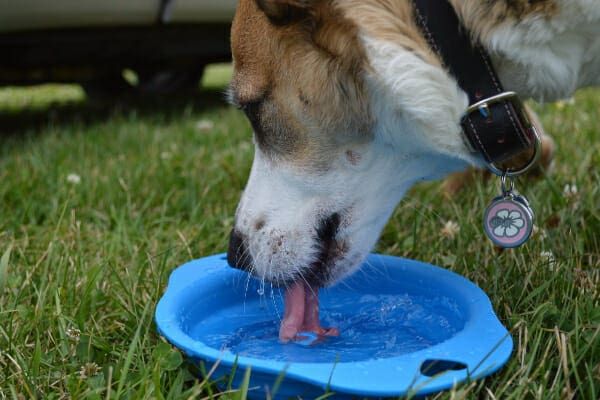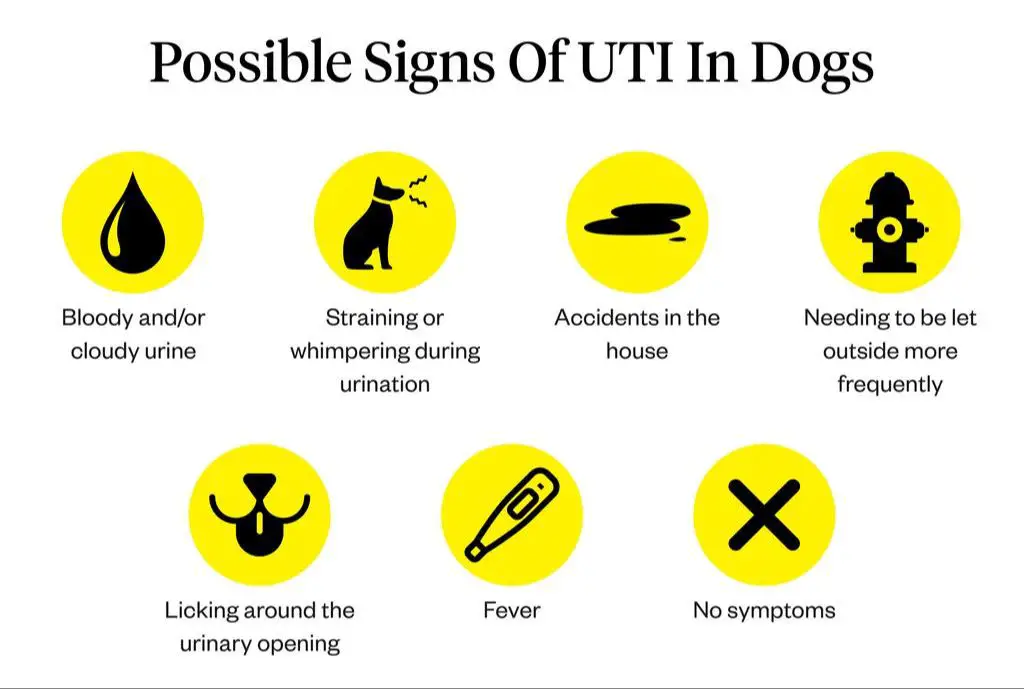What is a UTI in Dogs?
A urinary tract infection (UTI) is an infection of the urinary tract, which includes the urethra, bladder, ureters and kidneys. UTIs occur when bacteria enters and multiplies within the urinary tract, most commonly E. coli from the GI tract. According to veterinarians, UTIs affect approximately 14% of dogs throughout their lifetime.
Common symptoms of a UTI in dogs include:
- Frequent urination
- Difficulty urinating
- Straining to urinate
- Painful urination
- Blood in the urine
- Leaking urine
- Strong smelling urine
UTIs in dogs can be caused by bacteria ascending from the urethra into the bladder or descending from the kidneys into the ureters and bladder. Underlying causes include:
- Bladder stones
- Tumors
- Anatomical defects
- Prostate disease in males
Can a Dog’s UTI Go Away on Its Own?

Unfortunately, unlike in humans where UTIs may resolve without treatment in some cases, it is very unlikely for a dog’s UTI to go away on its own (source). The infection can quickly spread to the kidneys and become life threatening if left untreated.
While some very mild cases may potentially resolve without treatment, most require antibiotic therapy prescribed by a veterinarian. Trying to treat a dog’s UTI at home without professional guidance is not recommended.
Allowing a UTI to go untreated comes with serious risks. As the bladder infection worsens, bacteria can travel up the ureters to infect the kidneys. This kidney infection is known as pyelonephritis and can cause permanent kidney damage. Septicemia, a life-threatening blood infection, is also a possible complication.
Other risks of an untreated UTI progressing include incontinence issues, bladder or kidney stones forming, and cats developing a urethral obstruction which is an emergency. Overall, the consensus is that veterinary attention should be sought as soon as UTI symptoms arise in dogs.
When to See the Vet
It’s important to get your dog checked by a vet if you notice signs of a potential UTI. Though mild UTIs may resolve on their own, more severe infections can lead to complications if left untreated. There are a few key signs that indicate a vet visit is warranted:
Signs of a severe UTI include fever, vomiting, lethargy, and loss of appetite. These can indicate the infection may have spread to the kidneys and requires urgent veterinary attention (ASPCA).
You should also have your dog seen if symptoms last more than 24 hours without improvement. While it may take a couple days for antibiotics to fully clear the infection, you should notice some relief of symptoms within the first day (Daily Paws).
In general, the longer a UTI goes untreated, the higher the likelihood of complications. It’s recommended to get a vet exam within 1-2 days of noticing symptoms (ToeGrips). Your vet can run tests to diagnose the UTI and prescribe appropriate treatment.
Diagnosing a UTI
If a dog is showing signs of a possible UTI, the vet will perform a thorough physical exam and take the dog’s medical history. They will look for symptoms like frequent urination, straining to urinate, blood in the urine, or whimpering during urination.
The main diagnostic tool vets use is a urinalysis, which checks the dog’s urine for signs of infection. This involves collecting a urine sample and testing it for the presence of bacteria, white blood cells, and crystals. High white blood cell counts indicate inflammation from infection. The vet may also perform a urine culture to identify the specific bacteria causing the infection (https://vcahospitals.com/know-your-pet/urinary-tract-infections-utis-in-dogs).
Other tests the vet may recommend include bloodwork, x-rays, or ultrasound imaging. These can help rule out other conditions like kidney disease or bladder stones. In some cases, the vet may want to take radiographs to look for stones in the bladder or kidneys (https://bondvet.com/b/uti-in-dogs-symptoms-diagnosis-and-treatment).
Treating UTIs in Dogs
The most common treatment for UTIs in dogs is antibiotics prescribed by a veterinarian. Antibiotics work by killing the bacteria causing the infection. Some common antibiotics used are amoxicillin, cephalexin, trimethoprim-sulfa, and enrofloxacin (VCA Animal Hospitals).
The length of antibiotic treatment depends on the severity of the infection but is usually 7-14 days. It is important to finish the entire course of antibiotics as prescribed, even if your dog seems better, to fully eliminate the bacteria. Stopping treatment early can lead to recurrence (Animal Hospital of Clemmons).
In addition to antibiotics, veterinarians may recommend supportive care such as encouraging water intake, urinating frequently, and addressing pain or discomfort. Your vet may prescribe medications for pain, inflammation, or spasms. Special diets or nutritional supplements may also help support your dog’s urinary tract health.
Complications of UTIs
If left untreated, UTIs in dogs can lead to some serious complications. Some of the most common complications include:
Kidney Infection
One of the most serious complications of an untreated UTI is a kidney infection, also known as pyelonephritis. Bacteria from the bladder can migrate up to the kidneys and cause infection there. Symptoms of a kidney infection include fever, vomiting, lethargy, and increased urination. Kidney infections require urgent veterinary treatment with intravenous fluids and antibiotics (Source).
Prostate Infection
Male dogs can develop prostate infections as a complication of a UTI. Bacteria spreads from the urethra to the prostate gland. Symptoms include difficulty urinating, blood in the urine, and straining. Prostate infections need to be diagnosed and treated by a vet to avoid long-term urinary tract damage (Source).
Recurrence
Once a dog has had a UTI, they are more prone to getting another one. Some dogs may experience chronic or recurring UTIs if the underlying cause is not addressed. Working with your vet to identify risk factors and engage in prevention is important to stop the cycle of recurrent infections (Source).
Home Remedies
There are several home remedies that can help dogs recover from a UTI without antibiotics:

Increased Fluids
Drinking more water is the most basic home remedy for UTIs. Increased water intake helps flush bacteria out of the urinary tract. Give your dog fresh water throughout the day and consider adding broth or water to their meals.[1]
Diet Changes
Feeding canned or wet food can increase your dog’s water intake compared to dry kibble. Avoid foods high in sugars and carbs which may worsen a UTI. Consider adding supplements like D-mannose powder and cranberry extract to your dog’s meals as they may help prevent bacteria from sticking to the urinary tract.[2]
Supplements
Some natural supplements may help treat UTIs in dogs when used alongside increased fluids. Supplement options include D-mannose, cranberry, methionine, couch grass, parsley leaf, and marshmallow root. Consult your vet before giving supplements to ensure proper dosing for your dog.[3]
Prevention
There are several things you can do to help prevent UTIs in your dog:

Hygiene
Keeping your dog’s genital area clean is important for preventing bacteria from entering the urinary tract. Gently clean the area around the urinary opening with a damp cloth and mild, pet-safe soap and rinse well. Avoid using human soaps which can irritate the skin. Regular baths and grooming, especially trimming around the genitals, can also help keep bacteria at bay. According to Tufts University https://vetnutrition.tufts.edu/2023/08/can-diet-prevent-or-treat-urinary-tract-infections-in-dogs/, hygiene is a key part of UTI prevention.
Urinary Supplements
Certain supplements may help support urinary tract health and prevent UTIs. Ingredients like D-mannose, marshmallow root, and glucosamine have been shown to help form a protective coating over the bladder lining to prevent bacteria from adhering. According to WagWalking https://wagwalking.com/wellness/how-to-prevent-your-dog-from-getting-a-uti, these types of supplements can be a useful part of a UTI prevention regimen.
Dietary Changes
Making sure your dog stays well-hydrated is crucial for flushing bacteria out of the urinary tract. Provide fresh, clean water at all times and encourage drinking. You can also switch to a wet food diet or add water to dry kibble to increase moisture intake. Reducing salt and minerals may also help prevent UTIs according to Small Door Veterinary https://www.smalldoorvet.com/learning-center/medical/utis-in-dogs/. Your vet can recommend an appropriate low-mineral diet.
When to Call the Vet Again
If your dog’s UTI symptoms persist or return after a course of antibiotics, it’s important to follow up with your veterinarian. Recurrent UTIs in dogs may indicate an underlying issue that needs to be addressed. Some reasons to take your dog back to the vet include:
Symptoms that don’t improve within 2-3 days of starting antibiotics. The infection may be resistant to the initial antibiotic prescribed. Your vet can do a urine culture to identify the bacteria and determine the most effective antibiotic.
Symptoms return shortly after finishing a course of antibiotics. This may indicate that the initial infection wasn’t fully resolved. Your vet may prescribe a longer course or a different antibiotic.
Your dog has more than 2 UTIs in a 6-month period. Recurrent UTIs may be a sign of anatomical abnormalities, bladder stones, diabetes, or cancer. Your vet can perform additional diagnostic tests.
New symptoms develop like vomiting, lethargy, or blood in the urine. These may indicate a kidney infection or bladder inflammation, which require urgent veterinary care.
Your dog is unable to urinate or is straining frequently. This can lead to bladder rupture and is a medical emergency.
Close monitoring and follow-up care are crucial for clearing up recurrent UTIs in dogs. Your vet can also advise on prevention methods, like dietary changes or urinary health supplements to help reduce future infections.
Outlook and Prognosis

The prognosis for dogs with UTIs is overall very good, as they are highly treatable infections when addressed promptly (https://vcahospitals.com/know-your-pet/urinary-tract-infections-utis-in-dogs). With appropriate antibiotic treatment prescribed by a veterinarian, most dogs will make a full recovery within 1-2 weeks.
However, urinary tract infections can sometimes recur or fail to fully resolve, requiring follow-up care and additional medication. In rare cases, a stubborn infection could progress and lead to more serious kidney issues if left untreated. That’s why it’s crucial to complete the entire course of prescribed antibiotics and monitor your dog carefully for any lingering signs of UTI.
Overall, the short-term prognosis is very good when UTIs are promptly diagnosed and treated. Just be alert for potential recurrence and ready to follow up with your veterinarian if your dog does not seem fully recovered after initial treatment.